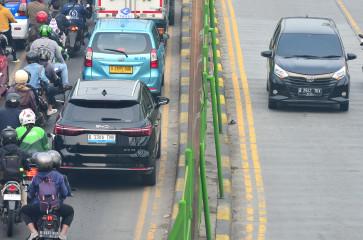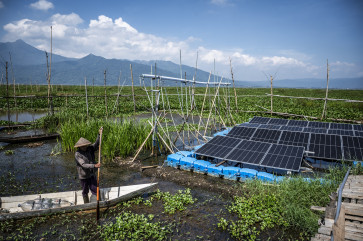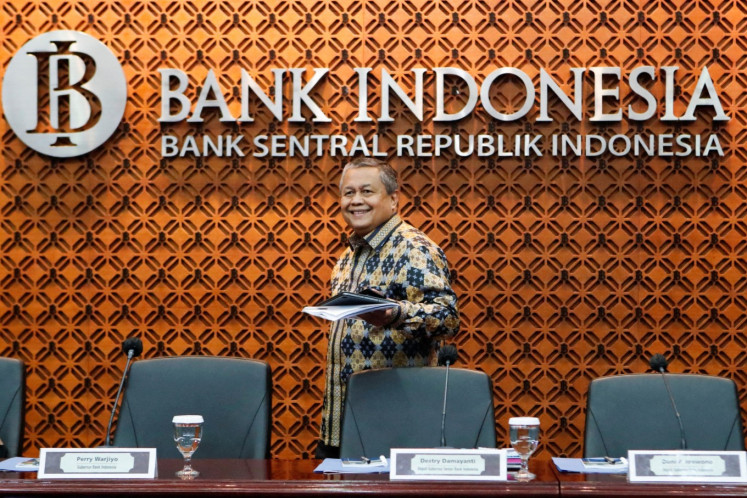Popular Reads
Top Results
Can't find what you're looking for?
View all search resultsPopular Reads
Top Results
Can't find what you're looking for?
View all search resultsMultifinance sector can boost Indonesian economy
Its potential comes from the automotive sector with around 80 percent of new car sales and motorcycles made using multifinance leases.
Change text size
Gift Premium Articles
to Anyone
 In the last five years, the growth of multifinance financing was considerably lower compared with the banking sector in the 2019-2023 period. Financing from multifinance only grew by an average of 2.3 percent, while the banking sector was able to grow its loans by an average of 6.1 percent. (Shutterstock/jamesteohart)
In the last five years, the growth of multifinance financing was considerably lower compared with the banking sector in the 2019-2023 period. Financing from multifinance only grew by an average of 2.3 percent, while the banking sector was able to grow its loans by an average of 6.1 percent. (Shutterstock/jamesteohart)
M
ultifinance companies have faced many challenges that have hampered their growth in the past five years, ranging from multiple pledging issues that eroded banks’ faith in multifinance to the pandemic that hit the economy hard. The prospects may further be hindered by not-so-optimistic global economic conditions. However, we believe Indonesia’s multifinance sector still holds immense potential and has the means to improve its resilience to external factors. The key is to reduce its dependence on several industries, improving its competitiveness and expanding its source of funds.
In the last five years, the growth of multifinance financing was considerably lower compared with the banking sector in the 2019-2023 period. Financing from multifinance only grew by an average of 2.3 percent, while the banking sector was able to grow its loans by an average of 6.1 percent. Its reliance on automotive and heavy equipment (around 85.8 percent in 2023 of its financing went to these industries) meant the sector suffered heavily during the pandemic.
Moreover, multifinance heavily relies on funding from banks, which still accounts for over 90 percent of its total funding, despite a decreasing trend. This high dependency on banks is due to the ease and speed of obtaining funding compared with issuing bonds. However, in 2019, the sector faced hurdles in gaining banks' trust due to multiple pledging, impacting competition, and favoring multifinance companies affiliated with banks.
Despite those challenges, we believe the multifinance sector still holds immense potential for growth. Its potential comes from the automotive sector with around 80 percent of new car sales and motorcycles made using multifinance leases. Furthermore, there are still many households that have the ability but do not yet own a car or a motorcycle. According to the National Socio-Economic Survey from Statistics Indonesia, 9.8 million out of 73.1 million households own a car. If we dissect the data further into the highest 20 percent of earners, then we estimate around 11 million households have yet to own a car. Following the same steps but looking into the highest 60 percent, we estimate around 8.6 million potential households have yet to own a motorcycle. However, aside from the automotive sector, multifinance still has the potential to expand its products to grasp a wider market.
There are at least two aspects of multifinance that need improvement to increase its demand and resilience. The first one is pricing and the second one is improving financial inclusion. The pricing of multifinance services mostly comes from interest rates charged to the customers. The pricing components of multifinance come from three aspects, including funding strategy, overhead costs and risk premium.
The funding strategy revolves around making the most efficient use of various funding sources, including bank loans, subordinate loans, issuing bonds or even issuing shares to accumulate funding or assets for business expansion. From a company perspective, multifinance entities affiliated with banks benefit from cheaper funding and can implement joint financing with their parent companies. Similarly, those affiliated with manufacturers may find it easier to lease goods at lower cost as they have the advantage of easier supply, giving them a competitive advantage. Consequently, those without affiliations may struggle to keep up with the competition. From the government perspective, it could increase the competition within the multifinance sector by easing the procedure to acquire funding, particularly from issuing bonds and/or shares.
Moreover, efficient operations, technology and human capital are crucial for reducing overhead costs in the multifinance sector. Utilizing the latest technology and innovations can streamline processes, reduce customer acquisition and maintenance costs, and ultimately increase profitability. By investing in efficient operations and human capital, multifinance companies can improve their competitiveness in the market.

















